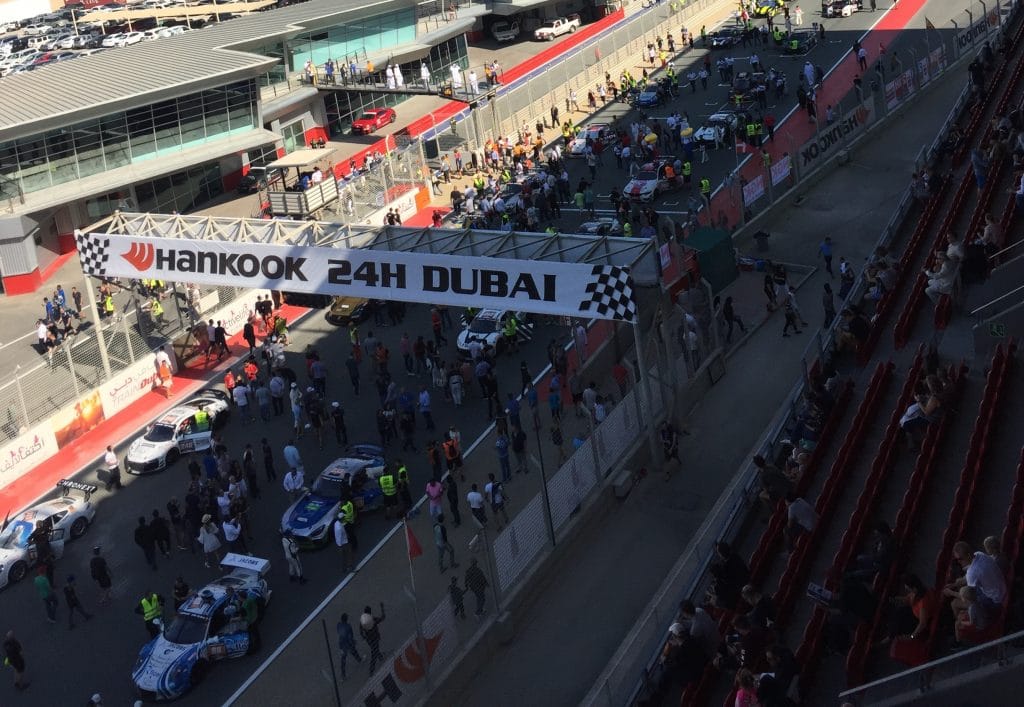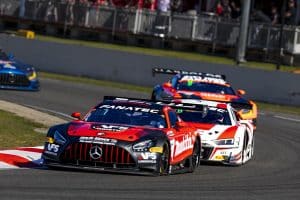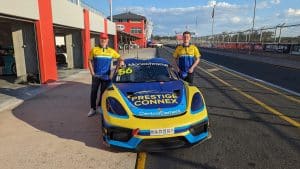It’s early Thursday morning at the Dubai Autodrome, and the back of the pits is buzzing with activity. Crew members are scurrying backwards and forwards between the freight containers and the garages, carrying equipment here and there and completing final preparations before the cars hit the track for official practice.
A total of 91 cars are entered for the 13th running of the Dubai 24 Hour, so if you multiply that number of cars by (conservatively) 15, to take into account drivers, crew, friends and family, you have some idea of the sheer number of people occupying the pits.
I’m walking behind the garages and I’m feeling completely overwhelmed. In amongst the frantic hive of activity and team members yelling at each other in foreign languages, I’ve come to the realisation that I’ve never been at a racetrack where I’ve felt so completely out of place as this one. Just like Sting in the song “Englishman in New York”, I might as well be an alien.
I continue my somewhat awkward stroll down the back of the pits when suddenly a voice rings out, in an accent that’s unmistakeably Australian:
“You’re a long way from home Lachy!”
With an enormous sense of relief I turn around and see former Carrera Cup Australia champ Nick Foster smiling at me. Thankful for seeing someone I know, I bound over and give him the firmest of handshakes.
I can’t put my finger on the reason why, but after that encounter with Nick, everything felt normal again. I was at a racetrack, about to watch an amazing endurance event and while I had to look a bit harder than back home in Australia, there would be people who I either already knew, or would be able to relate to through a common passion for motorsport.
The rest of the weekend was a fantastic experience and with the descriptive prose out of the way, I can drill into some discussion points to come out of the race.
Number of cars
With 91 cars jam-packed into a circuit shorter than Bathurst, and a large speed differential between the fastest and slowest cars in the field (about 25 seconds a lap), traffic management is an essential skill for all participants.
Impressively, there were very few incidents involving faster cars tangling with slower cars, but there were clear differences in the abilities of drivers in outright cars to efficiently negotiate their way through traffic.
A field this big is possible at the Dubai Autodrome, with its wide, open spaces and generous run-off areas, but it wouldn’t work at a circuit like Mount Panorama – a lot of sections of the track are just too tight and unforgiving.
Code 60
At the Dubai 24 Hour, there are no Safety Cars – if there’s an incident which requires intervention, a “Code 60” is initiated and all drivers must slow down to 60km/h.
I’ve advocated the use of a Code 60-type protocol for Australian races before, and having now seen it in action, I’m a fan. As well as the safety benefits of everyone slowing down immediately rather than racing – sometimes for almost a full lap – to catch the queue behind the Safety Car, the Code 60 system also means racing can resume immediately once incidents are cleared, and it means class battles aren’t distorted.
I’m not saying Code 60 should be applied universally in Australian motorsport, but it is something our sanctioning bodies need to look at more seriously.
And as I’ll detail below, the Dubai 24 Hour debunked the myth that you need Safety Cars to produce close finishes.
Strategic complexity
In order to create a fair contest, Dubai 24H organisers Creventic have introduced a number of regulations governing race strategy. These regulations seem to work well from a sporting perspective, but for punters playing along at home, the strategies can be quite tricky to follow.
For example, there are maximum driving times, minimum rest times between stints and maximum cumulative driving times for Pro-ranked drivers. There is also a regulation that any team that pits during a Code 60 period is only allowed to take on half of their fuel allocation.
At the Dubai 24 Hour, teams don’t refuel in their pit bay either – there’s a designated refuelling area with eight bowsers. If you arrive in the refuelling area and all eight spots are occupied, bad luck!
Being a race engineer and trying to manage the strategy for one car is a massive challenge in itself; being a commentator and trying to keep tabs on strategies for 91 cars, while explaining it to the audience in language that’s interesting and easy to understand, is ice-cream headache material.
I was fortunate enough to spend some of the race in the commentary box with the Radio Le Mans broadcasting team and my respect for those guys has skyrocketed, especially Paul Truswell who kept detailed notes on each car’s strategy while analysing timing data on an array of computer screens.
The subtle pleasure of endurance racing
Just like test cricket, endurance racing is not for those who want non-stop excitement and instant gratification. But for those who are prepared to be patient, and are able to appreciate evolving storylines and understand strategies as they unfold, long-distance races have their own special magic… and it’s something I love.
The 2018 Dubai 24 Hour saw the advantage ebbing and flowing between a number of the outright (A6) cars as different teams rose and fell with strategic masterstrokes, mechanical problems, brilliant individual stints and incidents.
A case in point was the Grasser Racing Lamborghini which started on pole position after a brilliant lap from Mirko Bortolotti, but fell down the order (outside the top 60!) with punctures in the first hour, before fighting back hard for the rest of the race and ultimately finishing third.
Also, for those who reckon Safety Cars are needed to keep the field close, think again: until the #3 Black Falcon Mercedes was eliminated in a crash inside the last four hours, the race seemed to be setting up for a blockbuster duel between the two Black Falcon entries, which were both on the lead lap and swapping positions repeatedly during pit stops. And the finishing margin between the second-placed Porsche and third-placed Lambo was less than 10 seconds, after 24 hours of racing and no Safety Cars to artificially bunch the field.
Aussies doing us proud
A contingent of Aussie drivers raced in the Dubai 24 Hour and did us proud by achieving great class results.
Highest-placed was Matt Campbell in the Fach Auto Tech Porsche, winning Class 991 Pro and finishing 14th outright.
It was a 1-2 finish for Aussies in 991 Pro, with Nick Foster finishing second. Foster had started on pole and led the class early, but lost time with a driveshaft failure.
Stephen Grove finished second in Class 991 Am (18th outright), only narrowly missing the class win after a great late-race battle.
The KTM X-Bow of Justin McMillan, Glen Wood, Nico Pronk and Peter Kox was classified 67th (5th in Class SP2) after a race fraught with mechanical problems, but in true Aussie style they never gave up.
Enlightenment
One feature of the Dubai 24 Hour is LED displays on each car, which display the position in which they are currently running. This makes it a lot easier for trackside spectators to understand the race, and I reckon it’s something that could be introduced in Australia. The technology was tested during a Dunlop Super2 race at Bathurst a couple of years ago, but hasn’t been seen since – hopefully it will reappear in the future.




